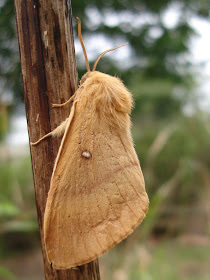 One of the more colourful moths found in the moth trap early on Friday 31st at the park was this ruby tiger. From the underneath the rich brick red colours of the body can be really appreciated. The moth is often seen in small numbers between mid July and early August here at the park.
One of the more colourful moths found in the moth trap early on Friday 31st at the park was this ruby tiger. From the underneath the rich brick red colours of the body can be really appreciated. The moth is often seen in small numbers between mid July and early August here at the park.The haul of moths in the trap was a below average but then Thursday night had been clear sky and a cool breeze blowing. About 55 individuals of 25 macro-moths were noted with poplar hawk, rosy rustic, copper underwing, drinker, red twin-spot carpet, cloaked minor, least carpet, riband wave, single-dotted wave, amongst the various moths found.
The sunshine brought out the butterflies onto the buddleias and it was nice to see a small tortoiseshell feeding amongst the 20 or so painted ladies. Red admiral, commas, small white, large whites, meadow browns and hedge browns have also been on this one bush in the car park.
The young sparrowhawk chicks are still noisy in the corner of the park, especially when the female was seen arriving with a small bird in its talons. A yellow wagtail flew over the park calling, while in the hedgerows by the pond lesser whitethroat, whitethroat and blackcaps were seen feeding amongst the berry bushes.
On the fields 2 green sandpipers and 15 black-tailed godwits were seen feeding around the muddy pools. Along the beach 60 turnstones and 20 dunlin were waiting for the tide to uncover the mud in front of the park. Andy Field noted 20 little terns in the river Colne in the morning.
 An evening walk along the Pyefleet Channel provided views of waders forced closer inshore by the incoming tide. The picture above shows mainly redshank with some dunlin also shelduck and black-headed gulls. The gathering of waders included 120 black-tailed godwits, 2 bar-tailed godwits, 150 redshank, 100 dunlin, 3 ringed plover, 1 red knot, 12 avocet and a whimbrel flying over calling.
An evening walk along the Pyefleet Channel provided views of waders forced closer inshore by the incoming tide. The picture above shows mainly redshank with some dunlin also shelduck and black-headed gulls. The gathering of waders included 120 black-tailed godwits, 2 bar-tailed godwits, 150 redshank, 100 dunlin, 3 ringed plover, 1 red knot, 12 avocet and a whimbrel flying over calling.On the Reeveshall pool were the mother and fledged avocet chick, 4 spotted redshank, green sandpiper, 2 little grebes, lapwing and 2 teal. On the big grass field 40 curlew were seen feeding and 8 brown hares lay close to the ground.
There seemed to be lots of little terns around with a group of 20 in the Colne feeding by Langenhoe Point, then two flocks of 20 each flew east along the Pyefleet. Only a few common terns were seen. On Langenhoe 5 marsh harriers were seen flying around or sitting on the seawalls.
 A sparrowhawk was seen dropping this half-eaten wood pigeon pictured above, as I walked through the Shop Lane wood. A second sparrowhawk was heard calling from the nearby trees. By the seawall a juvenile green woodpecker clung to a lone bush calling and nearby 200 starlings were feeding.
A sparrowhawk was seen dropping this half-eaten wood pigeon pictured above, as I walked through the Shop Lane wood. A second sparrowhawk was heard calling from the nearby trees. By the seawall a juvenile green woodpecker clung to a lone bush calling and nearby 200 starlings were feeding.


















































